Life Tables
|
| < Day Day Up > |
|
The data set analyzed in this task contains the survival times of rats in a small randomized trial. Forty rats were exposed to a carcinogen and assigned to one of two treatment groups. The survival time is the time from randomization to death. The event of interest is death from cancer induced by the carcinogen, and interest lies in whether the survival distributions differ between the two treatments. Four rats died of other causes, and their survival times are regarded as censored observations. The data set Exposed contains four variables: Days, Status, Treatmnt, and Gender. The Days variable contains survival times in days from randomization to death, and the Status variable has the value 0 for censored observations and 1 for uncensored observations. The Treatmnt variable has the value 1 if the rat was administered the first treatment or 2 if the rat was administered the second treatment, and the Gender variable has the value F if the rat is female and M if the rat is male.
Open the Exposed Data Set
The data are provided in the Analyst Sample Library. To open the Exposed data set, follow these steps:
-
Select Tools → Sample Data...
-
Select Exposed.
-
Click OK to create the sample data set in your Sasuser directory.
-
Select File → Open By SAS Name...
-
Select Sasuser from the list of Libraries.
-
Select Exposed from the list of members.
-
Click OK to bring the Exposed data set into the data table.
Request the Life Tables Analysis
To specify the Life Tables task, follow these steps.
-
Select Statistics → Survival → Life Tables...
-
Select Days as the time variable.
A common feature of lifetime or survival data is the presence of right-censored observations due either to withdrawal of experimental units or to termination of the experiment. The analysis methodology must correctly use the censored observations as well as the noncensored observations. In this analysis, the values of Days are considered censored if the value of Status is 0; otherwise, they are considered event times.
-
Select Status as the censoring variable.
-
Specify 0 as the censoring value by directly typing 0 in the Censoring values: field or by clicking on the down arrow under Censoring values: and selecting 0 from the list. You can remove censoring values by deleting the values in the field.
-
Select Treatmnt as the strata variable.
Figure 14.2 displays the dialog with Days specified as the time variable, Status specified as the censoring variable, 0 selected as the censoring value, and Treatmnt specified as the strata variable.
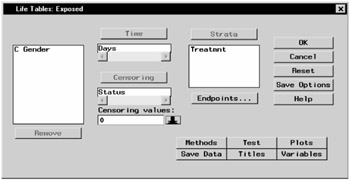
Figure 14.2: Life Tables Dialog
Request A Survivor Function Plot
To produce a plot of the survivor function, follow these steps:
-
Click Plots to open the Plots dialog.
-
Select Survival function.
-
Click OK.
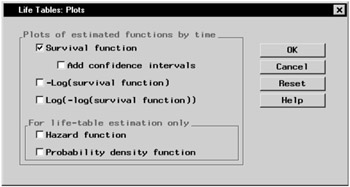
Figure 14.3: Life Tables- Plots Dialog
When you have completed your selections, click OK in the main dialog to produce the analysis.
Review the Results
The results are presented in the project tree under the Life Tables folder, as displayed in Figure 14.4. The three nodes represent the life tables output, the survivor distribution function plot, and the SAS programming statements (labeled Code) that generated the output.
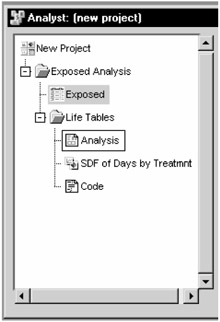
Figure 14.4: Life Tables- Project Tree
You can double-click on any node in the project tree to view the contents in a separate window.
Figure 14.5 displays summary statistics for the survival times for rats administered treatment 2. Of greatest interest is the 50th percentile, which is the median survival time. Here, rats administered treatment 2 have a median survival time of 235.5 days with a 95-percent confidence interval of 209 to 253. The mean survival time is 235.156 with a standard error of 10.211.

Figure 14.5: Life Tables- Results
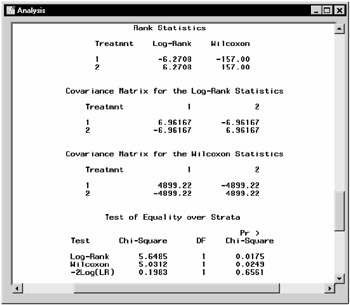
Figure 14.6: Life Tables- Test for Equality over Strata
The "Test for Equality over Strata" table contains rank and likelihood-based statistics for testing homogeneity of survivor functions across strata. The rank tests for homogeneity indicate a significant difference between the treatments (p=0.0175 for the log-rank test and p=0.0249 for the Wilcoxon test), where rats in the first treatment group live significantly longer than those in the second treatment group. The log-rank test, which places more weight on larger survival times, has a lower p-value than the Wilcoxon test, which places more weight on early survival times.
Figure 14.7 displays the survivor function against time for each of the two treatments. The gap between the two curves distinguishes between the survival distributions, where the curve for treatment 1 decreases after the curve for treatment 2. The difference in displayed survival curves reinforces the conclusions that the rats in the first treatment group live longer than rats in the second group.
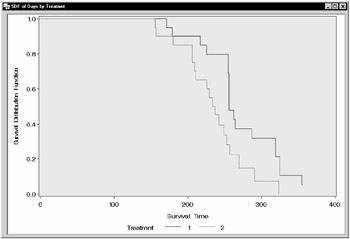
Figure 14.7: Life Tables- Survivor Distribution Plot
|
| < Day Day Up > |
|
EAN: 2147483647
Pages: 116